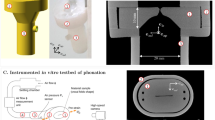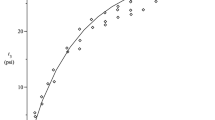Abstract
The vocal folds are known to be mechanically anisotropic due to the microstructural arrangement of fibrous proteins such as collagen and elastin in the lamina propria. Even though this has been known for many years, the biomechanical anisotropic properties have rarely been experimentally studied. We propose that an indentation procedure can be used with uniaxial tension in order to obtain an estimate of the biomechanical anisotropy within a single specimen. Experiments were performed on the lamina propria of three male and three female human vocal folds dissected from excised larynges. Two experiments were conducted: each specimen was subjected to cyclic uniaxial tensile loading in the longitudinal (i.e., anterior–posterior) direction, and then to cyclic indentation loading in the transverse (i.e., medial–lateral) direction. The indentation experiment was modeled as contact on a transversely isotropic half-space using the Barnett–Lothe tensors. The longitudinal elastic modulus E L was computed from the tensile test, and the transverse elastic modulus E T and longitudinal shear modulus G L were obtained by inverse analysis of the indentation force-displacement response. It was discovered that the average of E L /E T was 14 for the vocal ligament and 39 for the vocal fold cover specimens. Also, the average of E L /G L , a parameter important for models of phonation, was 28 for the vocal ligament and 54 for the vocal fold cover specimens. These measurements of anisotropy could contribute to more accurate models of fundamental frequency regulation and provide potentially better insights into the mechanics of vocal fold vibration.
Similar content being viewed by others
References
Alipour F, Berry D, Titze I (2000) A finite-element model of vocal-fold vibration. J Acoust Soc Am 108: 3003–3012
Barnett D, Lothe J (1975) Line force loadings on anisotropic half-spaces and wedges. Phys Norv 8: 13–22
Berry D, Titze I (1996) Normal modes in a continuum model of vocal fold tissues. J Acoust Soc Am 100: 3345–3354
Bühler R, Sennes L, Tsuji D, Mauad T, da Silva L, Saldiva P (2011) Collagen type I, collagen type III, and versican in vocal fold lamina propria. Arch Otolaryngol Head Neck Surg 137: 604–608
Butler J, Hammond T, SD G (2001) Gender-related differences of hyaluronic acid distribution in the human vocal fold. Laryngoscope 111: 907–911
Chan R, Rodriguez M (2008) A simple-shear rheometer for linear viscoelastic characterization of vocal fold tissues at phonatory frequencies. J Acoust Soc Am 124: 1207–1219
Chan R, Titze I (2003) Effect of postmortem changes and freezing on the viscoelastic properties of vocal fold tissues. Ann Biomed Eng 31: 482–491
Chan R, Fu M, Young L, Tirunagari N (2007) Relative contributions of collagen and elastin to elasticity of the vocal fold under tension. Ann Biomed Eng 35: 1471–1483
Chan R, Siegmund T, Zhang K (2009) Biomechanics of fundamental frequency regulation: constitutive modeling of the vocal fold lamina propria. Logop Phoniatr Voco 34: 181–189
Chhetri D, Zhang Z, Neubauer J (2011) Measurement of young’s modulus of vocal folds by indentation. J Voice 25: 1–7
Cook D, Nauman E, Mongeau L (2009) Ranking vocal fold model parameters by their influence on modal frequencies. J Acoust Soc Am 126: 2002–2010
Cox M, Driessen N, Boerboom R, Bouten C, Baaijens F (2008) Mechanical characterization of anisotropic planar biological soft tissues using finite indentation: experimental feasibility. J Biomech 41: 422–429
Dahan M, Zarka J (1977) Elastic contact between a sphere and a semi infinite transversely isotropic body. Int J Solids Struct 13: 229–238
de Vries M, Schutte H, Verkerke G (1999) Determination of parameters for lumped parameter models of the vocal folds using a finite element method approach. J Acoust Soc Am 106: 3620–3628
Dong X, Guo X (2004) The dependence of transversely isotropic elasticity of human femoral cortical bone on porosity. J Biomech 37: 1281–1287
Fan Z, Swadener J, Rho J, Roy M, Pharr G (2002) Anisotropic properties of human tibial cortical bone as measured by nanoindentation. J Orthop Res 20: 806–810
Gefen A, Margulies S (2004) Are in vivo and in situ brain tissues mechanically similar. J Biomech 37: 1339–1352
Gray S (2000) Cellular physiology of the vocal folds. Otolaryng Clin N Am 33: 679–697
Gray S, Titze I, Alipour F, Hammond T (2000) Biomechanical and histological observations of vocal fold fibrous proteins. Ann Otol Rhinol Laryngol 109: 77–85
Haji T, Mori K, Omori K, Isshiki N (1992) Mechanical properties of the vocal fold. stress-strain studies. Acta Otolaryngol (Stockh) 112: 559–565
Hammond T, Gray S, Butler J (2000) Age- and gender-related collagen distribution in human vocal folds. Ann Otol Rhinol Laryngol 109: 913–920
Hirano M, Kakita Y, Ohmaru K, Kurita S (1982) Structure and mechanical properties of the vocal fold. In: Lass N (ed) Speech and language: advances in basic research and practice, vol 7, Academic Press, New York, pp 271–297
Ishii K, Zhai W, Akita M, Hirose H (1996) Ultrastructure of the lamina propria of the human vocal fold. Acta Otolaryngol (Stockh) 116: 778–782
Kelleher J, Zhang K, Siegmund T, Chan R (2010) Spatially varying properties of the vocal ligament contribute to its eigenfrequency response. J Mech Behav Biomed 3: 600–609
Kelleher J, Siegmund T, Chan R, Henslee E (2011) Optical measurements of vocal fold tensile properties: implications for phonatory mechanics. J Biomech 44: 1729–1734
Kelleher J, Siegmund T, Chan R (2012) Could spatial heterogeneity in human vocal fold elastic properties improve the quality of phonation? Ann Biomed Eng. doi:10.1007/s10439-012-0609-1
Lothe J, Barnett D (1976) On the existence of surface-wave solutions for anisotropic elastic half-spaces with free surface. J Appl Phys 47: 428–433
Lotz J, Gerhart T, Hayes W (1991) Mechanical properties of metaphyseal bone in the proximal femur. J Biomech 24: 317–329
Mattice J, Lau A, Oyena M, Kent R (2006) Spherical indentation load-relaxation of soft biological tissues. J Mater Res 21: 2003–2010
Madruga de Melo E, Lemos M, Aragao Ximenes Filho J, Sennes L, Nascimento Saldiva P, Tsuji D (2003) Distribution of collagen in the lamina propria of the human vocal fold. Laryngoscope 113: 2187–2191
Min Y, Titze I, Alipour-Haghighi F (1995) Stress-strain response of the human vocal ligament. Ann Otol Rhinol Laryngol 104: 563–569
Miri A, Tripathy U, Mongeau L, Wiseman P (2012) Nonlinear laser scanning microscopy of human vocal folds. Laryngoscope 122: 356–363
Monniere V, Sell D (1994) Collagen as a biomarker of aging. In: Balin A (eds) Practical handbook of human biological age determination. CRC Press, Boca Raton
Moore S, McMahon P, Debski R (2004) Bi-directional mechanical properties of the axillary pouch of the glenohumeral capsule: implications for modeling and surgical repair. J Biomech Eng 126: 284–288
Moore S, McMahon P, Azemi E, Debski R (2005) Bi-directional mechanical properties of the posterior region of the glenohumeral capsule. J Biomech 38: 1365–1369
Popov V (2010) Contact mechanics and friction. Springer, Berlin
Quapp K, Weiss J (1998) Material characterization of human medial collateral ligament. J Biomech Eng 120: 757–763
Sato K, Hirano M (1997) Age-related changes of elastic fibers in the superficial layer of the lamina propria of vocal folds. Ann Otol Rhinol Laryngol 106: 44–48
Swadener J, Pharr G (2001) Indentation of elastically anisotropic half-spaces by cones and parabolae of revolution. Philos Mag A 81: 447–466
Swanson S (2004) Hertzian contact of orthotropic materials. Int J Solids Struct 41: 1945–1959
Tateya T, Tateya I, Bless D (2006) Collagen subtypes in human vocal folds. Ann Otol Rhinol Laryngol 115: 469–476
Thibeault S, Gray S, Bless D, Chan R, Ford C (2002) Histologic and rheologic characterization of vocal fold scarring. J Voice 16: 96–104
Ting T (1996) Anisotropic elasticity. Oxford University Press, New York
Titze I (1976) On the mechanics of vocal-fold vibration. J Acoust Soc Am 60: 1366–1380
Titze I (2000) Principles of voice production, 2nd edn. National Center for Voice and Speech, Denver
Titze I (2006) The myoelastic aerodynamic theory of phonation. National Center for Voice and Speech, Iowa City
Tran Q, Berke G, Gerratt B, Kreiman J (1993) Measurement of young’s modulus in the in vivo human vocal folds. Ann Otol Rhinol Laryngol 102: 584–591
Turner J (1980) Contact on a transversely isotropic half-space, or between two transversely isotropic bodies. Int J Solids Struct 16: 409–419
Vlassak J, Ciavarella M, Barber J, Wang X (2003) The indentation modulus of elastically anisotropic materials for indenters of arbitrary shape. J Mech Phys Solids 51: 1701–1721
Willis J (1966) Hertzian contact of anisotropic bodies. J Mech Phys Solids 14: 163–176
Yoo L, Reed J, Shin A, Kung J, Gimzewski J, Poukens V, Goldberg R, Mancini R, Taban M, Moy R, Demer J (2011) Characterization of ocular tissues using microindentation and hertzian viscoelastic models. Invest Ophthalmol Vis Sci 52: 3475–3482
Yu H (2001) A concise treatment of indentation problems in transversely isotropic half-spaces. Int J Solids Struct 38: 2213–2232
Zhang K, Siegmund T, Chan R (2007) A two-layer composite model of the vocal fold lamina propria for fundamental frequency regulation. J Acoust Soc Am 122: 1090–1101
Zhang K, Siegmund T, Chan R (2009) Modeling of the transient responses of the vocal fold lamina propria. J Mech Behav Biomed 2: 93–104
Zhupanska O (2010) Indentation of a rigid sphere into an elastic half-space in the direction orthogonal to the axis of material symmetry. J Elast 99: 147–161
Author information
Authors and Affiliations
Corresponding author
Rights and permissions
About this article
Cite this article
Kelleher, J.E., Siegmund, T., Du, M. et al. Empirical measurements of biomechanical anisotropy of the human vocal fold lamina propria. Biomech Model Mechanobiol 12, 555–567 (2013). https://doi.org/10.1007/s10237-012-0425-4
Received:
Accepted:
Published:
Issue Date:
DOI: https://doi.org/10.1007/s10237-012-0425-4




